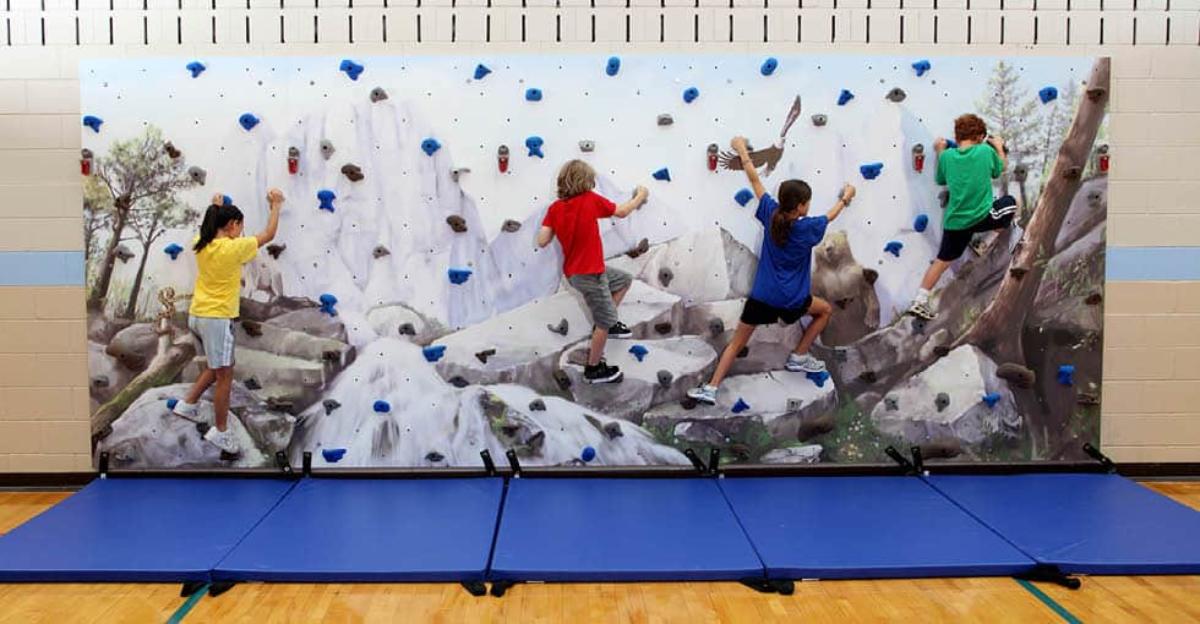You’ve heard about it from other physical educators. You’ve seen kids climbing and think it would be the perfect addition to your physical education program. But you don’t know where to begin and need to know more. Here’s everything you need to know!
Why Rock Climbing?
There are many reasons that rock climbing is a desirable addition to a physical education program. Here are the top 3 reasons:
- Climbing develops the whole child—body, mind and spirit. While climbing, children are also developing strength, endurance and flexibility. They’re using their brains to problem solve and make decisions, choosing the appropriate hand and foot holds to reach their goal. On a social-emotional level, they’re overcoming challenges, persevering and developing confidence.
- Rock Climbing engages participants from a wide range of ages, fitness levels, abilities and interests. Climbing walls and activities can be differentiated to meet the needs of participants ages 3 and up. Special features of the wall allow for use by beginners, experienced climbers and those with disabilities. As a welcome alternative to traditional sports, climbing often appeals to youth not previously motivated in physical education classes. Educators report that climbing offers a measure of success for all children.
- Rock climbing aligns with National Standards and Grade-Level Outcomes for K-12 Physical Education. Climbing helps children develop motor skills, movement patterns, strategies and responsible behavior.
Now that you understand the “why” behind climbing, let’s focus on the “how.”
How do I Choose the Right Climbing Wall?
There are a lot of options out there for Traverse Walls® and it can be overwhelming. Where to begin? Here are the top 5 questions to ask yourself. The answers will direct you to the climbing wall that best meets your needs:
What is the Age of the Climbers?
The age of your students is a main consideration in choosing your climbing wall. What grade levels do you teach? This will help determine the height of the climbing wall.
If you teach elementary-age children, an 8-foot high Traverse Wall is going to be best for you. On this type of climbing wall, students climb horizontally, or traverse the wall. The challenge is to make it all the way across, and even back again, without climbing down to rest. It’s harder than it sounds! And with a Traverse Wall, students’ feet are never more than 3 feet from the safety mats.
If you teach students in middle school, you will want to consider a 10-foot high Traverse Wall, which accommodates the taller height and longer reach of adolescents. To help keep these older students challenged, it’s also a good idea to offer new experiences like the Challenge Course, an on-the-wall obstacle course.
What Activities Do You Want to Conduct?
Thinking about how you will use a climbing wall with students will help you choose a panel style for your climbing wall. Would you like to strictly focus on developing climbing skills and technique, or would you like to conduct cross-curricular activities?
If your focus is primarily climbing skill development, consider a climbing wall with a rock-realistic look and feel or a mountain mural scene to give the feeling of climbing outdoors.
If you would like to integrate climbing with other subject areas, consider a climbing wall with a magnet-accepting and write-on surface. These types of Traverse Walls make it easy to host math, language and other activities.
Do you teach Adaptive or Unified Physical Education? If so, an Adaptive Climbing Wall may best suit your needs. Along with traditional hand holds, this climbing wall features grab-bar style hand holds and ledge-style foot holds to assist children with physical disabilities in achieving success on the wall.
What Special Features Do You Want?
Another way to help narrow down the many choices available, is to think about certain features of your climbing wall and how they could help meet your program goals.
Some climbing walls feature different color hand holds that correspond to different levels of challenge. Color-coded hand holds are high on many educators’ wish list because they allow students to choose their level of challenge and makes the climbing wall appropriate for a variety of ages and abilities. It’s a climbing wall that can “grow” right along with students.
Some Traverse Walls feature a horizontal line, like the Red-Relief Line®, above which students’ feet should never go. This safety feature helps supervisors monitor how high students are climbing and also helps to remind climbers to stay within the safety zone.
Along the lines of safety, a simple way to close the climbing wall to deter unsupervised use is a very desirable feature. Many climbing walls offer a system to close and lock the wall by folding the safety mats up against the wall and locking them to special hand holds. A Mat-Locking System not only closes the climbing wall, but also provides protrusion protection from the climbing wall when the gym is being used for other activities.
What Space Do You Have?
For use in a physical education class, the recommended minimum size climbing wall is 8’-high by 20’-long. This allows for 10 students to be engaged at one time (5 climbers, each with a non-climbing partner). Keep in mind that the safety mats extend 6 feet out from the climbing wall. That means the required space is about 9-feet high by 22-feet wide by 7-feet deep. The more space you have, lengthwise, the longer your climbing wall can be and the more students it can engage at one time.
If you want to consider a Top Rope Climbing Wall, you should have at least 20’-high ceilings.
Do not worry about corners, pillars, air vents or electrical outlets. Many climbing walls go around corners and pillars and special accommodations can be made to cut out for vents and outlets.
If you don’t have available wall space, a freestanding climbing wall is the solution.
For those schools without gyms, there’s still hope. Climbing walls can be put in hallways, classrooms, lunchrooms and outside.
The main thing to keep in mind if you are going to use a nontraditional space for your climbing wall is that mats need to extend 6 feet from the climbing wall. Be sure there is enough space for that and be sure the mats will not be blocking access to closets or other rooms.
What is Your Budget?
There is a wide price range for climbing walls to meet all budgets. Traverse Walls start at $4,720.99 for an 8’-high by 20’-long wall. Logically, adding to the length and height of the wall increases the price. Panel surfaces and styles also impact the budget. The most economical panel is basic wood or textured wood. Moving up in price allows you to have a rock-realistic look and feel or a cross-curricular panel. A Mural Wall can bring in scenes of nature or even a custom look with your school’s mascot or original artwork. There’s a special look within each price range.
If you need funding for your wall, consider a partnership with your PTA/PTO. Often these organizations raise money to support the installation of a climbing wall when they learn about the benefits climbing brings to children.
Best wishes as you look into expanding your physical education offerings and reach new heights with a rock climbing wall!






Hello.
I like your home page photo with the climbing kids 🙂 I am now studying a master program.
I wished i know if i can use it in an article that i write about school architecture, in a romanian design magazine – ARGUMENT.
If so, how should i cite the wrights?
Thank you so much,
Have a great day
Iulia Vasile